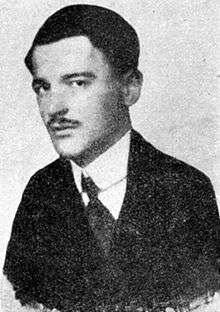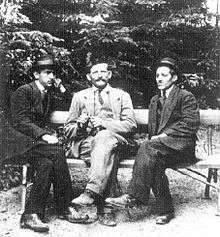Nedeljko Čabrinović
| Nedeljko Čabrinović | |
|---|---|
 Nedeljko Čabrinović, c.1910s | |
| Born |
2 February 1895 Sarajevo, Condominium of Bosnia and Herzegovina, Austro-Hungarian Empire |
| Died |
20 January 1916 (aged 20) Terezín, Austro-Hungarian Empire |
| Cause of death | Tuberculosis |
| Resting place | Saint Mark Cemetery, Sarajevo |
Nedeljko Čabrinović (Serbian Cyrillic: Недељко Чабриновић; 2 February 1895 – 20 January 1916)[1][2] was a Bosnian Serb member of the pro-Yugoslav[3] Young Bosnia movement and one of seven young men of a secret society known as the Black Hand who conspired to assassinate Archduke Franz Ferdinand of Austria during his June 1914 visit to Sarajevo.
All seven men were arrested; during the trial, Čabrinović and other members stated that the assassination reflected their anarchist beliefs.[4] In response, Austria-Hungary issued a démarche to Serbia known as the July Ultimatum, leading to the outbreak of World War I.
Early life
Nedeljko Čabrinović was born in Sarajevo, Bosnia on 2 February 1895, during the rule of the Austro-Hungarian Empire. Nedeljko was the oldest of five children from his father's first marriage.
His father kept a small catering operation on the outskirts of the city. His father's rudeness and physical abuse led to Čabrinović leaving home and dropping out of school in his teen years. He would become a locksmith and tinsmith, before settling down as a graphic worker.
Čabrinović found himself in a difficult financial position after leaving home, but was also bitter and miserable because of the social situation of the working class in general. As an opponent of "class exploiters", he participated in organizing a series of strikes in Sarajevo and other cities in Bosnia, for which he was often politically persecuted and expelled from various cities. At a very early age he started to read a variety of books and at one point lived in Zagreb and Trieste while trying to become financially stable on his own. He finally found a good job at a print shop in Belgrade, becoming familiar with anarchist literature. By his own account, he earned 90 dinars per month, which was not enough to pay for rent and food, let alone books, which, for Čabrinović, were "the only sign of life."
Young Bosnia

In the meantime, he met Gavrilo Princip, and joined the Black Hand in 1912.[5] Two years later, Dragutin Dimitrijević leader of the Black Hand, ordered Čabrinović, Gavrilo Princip and five other conspirators to assassinate Austro-Hungarian Archduke Franz Ferdinand, giving them each a gun and two bombs.
Sarajevo assassination
On Sunday, 28 June 1914, Archduke Franz Ferdinand of Austria and his wife Sophie, Duchess of Hohenberg were assassinated in Sarajevo by Gavrilo Princip during a visit that had been announced two months prior. General Oskar Potiorek, Governor of the Austrian provinces of Bosnia and Herzegovina had invited Franz Ferdinand and Countess Sophie to the opening of a hospital. The Archduke knew that the visit would be dangerous, knowing his uncle, Emperor Franz Josef, had been the subject of an assassination attempt by the Black Hand in 1911.
Just before 10 a.m. on Sunday, the royal couple arrived in Sarajevo by train. In the front car was Fehim Čurčić, the mayor of Sarajevo and Dr. Gerde, the city's Commissioner of Police. Franz Ferdinand and Sophie were in the third car with Oskar Potiorek and Lieutenant Colonel Count Franz von Harrach. The car's top was rolled back in order to allow the crowds a good view of its occupants.
Čabrinović, Grabež and Gavrilo Princip, were all suffering from tuberculosis and knew they would not live long; the other four men hated Franz Ferdinand. They were, therefore, willing to give their life for what they believed was a great cause: Bosnia and Herzegovina achieving independence from Austria-Hungary.
The six conspirators lined the route. They were spaced out along the Appel Quay, each one with instructions to try to kill Franz Ferdinand when the royal car reached his position. The first conspirator on the route to see the royal car was Muhamed Mehmedbašić. Standing by the Austro-Hungarian Bank, Mehmedbašić lost his nerve and allowed the car to pass without taking action. Mehmedbašić later said that a policeman was standing behind him and feared he would be arrested before he had a chance to throw his bomb.
At 10:15, when the six-car procession passed the central police station, Čabrinović hurled a hand grenade at the Archduke's car. The driver accelerated when he saw the object flying towards him, but the bomb had a 10 second delay and exploded under the wheel of the fourth car. Two of the occupants, Eric von Merizzi and Count Alexander von Boos-Waldeck were slightly wounded. About a dozen spectators were also hit by bomb shrapnel.[6]
After Čabrinović's bomb missed the Archduke's car, four other conspirators lost an opportunity to attack because of the heavy crowds and the high speed of the Archduke's car. To avoid capture, Čabrinović swallowed a cyanide capsule and jumped into the River Miljacka to make sure he died. The cyanide pill was expired and made him sick but failed to kill him, and the River Miljacka was only 10 centimetres (4 in) deep. A few seconds later he was hauled out and detained by police. As he was taken away, he supposedly was heard saying "I am a Serb hero."
Franz Ferdinand later decided to go to the hospital and visit the victims of Čabrinović's failed bombing attempt. In order to avoid the city centre, General Oskar Potiorek decided that the royal car should travel straight along the Appel Quay to the Sarajevo Hospital. However, Potiorek forgot to inform the driver, Leopold Loyka, about this decision. On the way to the hospital, Loyka took a right turn into Franz Josef Street.
Gavrilo Princip was standing near Moritz Schiller's cafe, when he spotted Franz Ferdinand's car as it drove past, having taken the wrong turn. After realizing the mistake, the driver put his foot on the brake and began to reverse the car. In doing so the engine of the car stalled and the gears locked, giving Princip his opportunity. Princip stepped forward, drew his pistol (a .380 caliber FN Model 1910[7]), and at a distance of about 1.5 m (five feet), fired twice into the car. Franz Ferdinand was hit in the neck and Sophie (who instinctively covered Franz's body with her own after the first shot) in the abdomen. They both died before 11:00.
Aftermath and death

Čabrinović confessed to his crimes, but believed himself a Serb hero and true anarchist, claiming:
We are not criminals. We are honest people, animated by noble sentiments; we are idealists; we wanted to do good; we have loved our people; and we shall die for our ideals.
As he was still a minor, he was not executed, but was sentenced to twenty years in prison. He died on 20 January 1916 of tuberculosis in a Terezín prison.[8]
He was secretly buried by Austro-Hungarian officials in Sarajevo in a cemented grave right after his death. Two years later, when Gavrilo Princip died, also of tuberculosis, they were buried in the same grave. Both assassins died before the "Great War" ended and without seeing the defeat and collapse of the Austro-Hungarian Empire.[9]
After Čabrinović's arrest, his mother also ended up in prison in Sarajevo, where she died. His father was interned in the Bosanska Krajina. Soon after, he married a widow, and from this marriage were born a daughter Dušanka and a son, who died young. Čabrinović's father died in 1930, the result of torture in a Sarajevo prison. Later that same year, his widow moved with their children to Belgrade.[10]
Letter from children of Franz Ferdinand
During the trial of the men accused of the assassination of Ferdinand and his wife, Čabrinović was the only defendant to express regrets and apologize to the children of the victims. The children, Princess Sophie, Max and Ernst, were told about Čabrinović's apology and wrote a letter to him. In the letter, they said they had heard about his apology and stated that his conscience could be at peace because they forgave him for his role in the murder of their parents. Sophie and Max signed the letter; Ernst refused. The letter was delivered personally to Cabrinovic, by the Jesuit Father Anton Puntigam, in his cell at Theresienstadt. On 23 January 1916, Sophie, Max and Ernst were informed that Čabrinović had died.[11]
References
- ↑ "Vremeplov (2. februar)". RTS. 2 February 2010. Retrieved 12 August 2013.
- ↑ "DANAS JE SUBOTA, 20. JANUAR". Sarajevo-rs. 20 January 2007. Retrieved 12 August 2013.
- ↑ Matjaž Klemenčič,Mitja Žagar. The Former Yugoslavia's Diverse Peoples: A Reference Sourcebook. ABC Clio. Retrieved 12 October 2014.
- ↑ Trivo Indic (27 May 1990). "The anarchist tradition on Yugoslav soil". Umanità Nova. Retrieved 17 October 2014.
- ↑ "Revolucionari i Srbi i Muslimani". Novosti. 18 June 2004. Retrieved 12 August 2013.
- ↑ Dedijer, Vladimir (1966). "Chapter XIV". The Road to Sarajevo. New York: Simon and Schuster. footnote 21. OCLC 400010.
- ↑ Belfield, Richard (2011). A Brief History of Hitmen and Assassinations. Constable & Robinson, Ltd. p. 241.
- ↑ "Obeležena 90. godišnjica smrti Gavrila Principa". Glas-javnosti. 28 April 2008. Retrieved 12 August 2013.
- ↑ "Vremeplov". RTV. 20 January 2009. Retrieved 12 August 2013.
- ↑ "Moj brat Nedeljko". Glas-javnosti. 18 April 2008. Retrieved 12 August 2013.
- ↑ The Assassination of the Archduke, Greg King and Sue Woolmans (Macmillan) 2013, p.246 ISBN 978-1-4472-4521-6
External links
| Wikimedia Commons has media related to Nedeljko Čabrinović. |